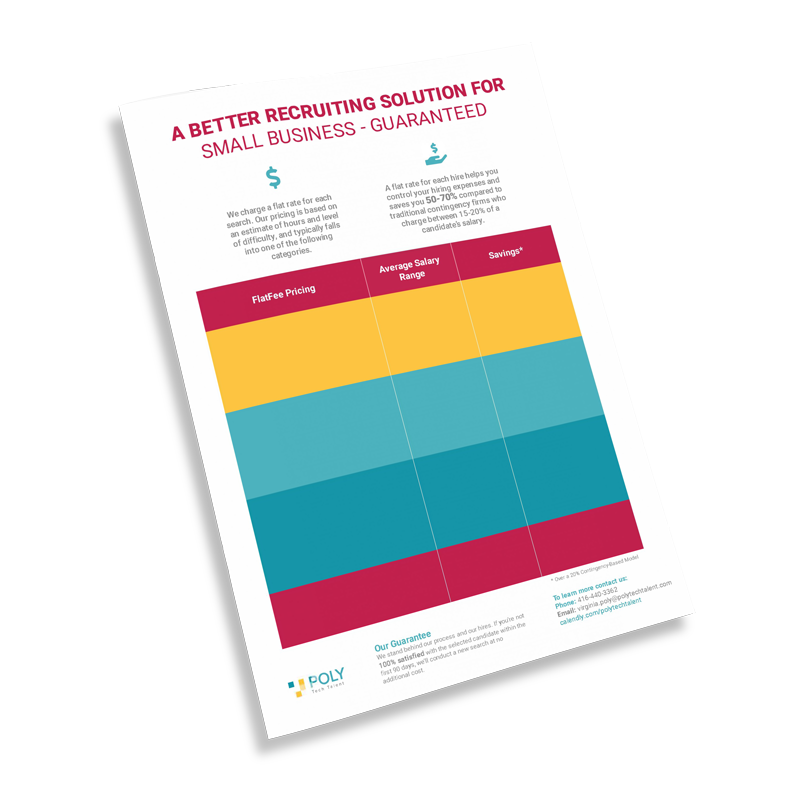Is Your Current Hiring Process Delivering The People You Need?
Why You Should Consider FlatFee IT Recruiting
Most organizations make decisions around how they will recruit based on the cost of recruitment. The standard formula typically includes things like internal recruiter salaries, employee referral bonuses, interview costs (# of hours X hourly salary of the interviewer and/or hiring manager). Plus adding in fixed costs such as physical infrastructure, external recruiting costs (agency fees), advertising costs like job boards and more.
Yes, that is a pretty solid formula. But it doesn’t include one of the biggest hiring costs most companies face today.
The Biggest Recruiting Cost is Actually Hiring Mistakes
Did you know the average hiring mistake costs 15x’s an employee’s base salary in hard costs and productivity? A single bad hire on a $100K employee can cost a company $1.5M or more!
This is why we developed FlatFee IT as an alternative to the traditional recruiting methods. Its process covers both sides of the recruiting coin, bringing in the right candidate for your team at a fraction of the cost and providing a roadmap to help keep them. Our FlatFee IT process leads to our staggering success rate of 94% of our candidates placed are still on the job 12 months later.
It’s time to take a look at your current hiring method to ensure you are using the process and partner that brings you and your team the most success long term.
FlatFee IT Fee Guide
Download our FlatFee IT chart today to learn the incredible value the FlatFee IT recruiting process can bring to your business.

FlatFee IT Recruiting versus Other Common Recruiting Methods
Traditional Contingency based IT recruiting is just how it’s always been done. But is it the best way for your company? Inhouse recruiting can be great because your recruiting employees are immersed in your culture, but is it the most cost efficient for your small to medium-sized business?
Stop and take a serious look at how FlatFee IT Recruiting can provide a better solution to the traditional models. Its design is built to partner with your company and bring in today’s top tech talent (plus includes a roadmap to the new hire’s first year on the job) while you keep a consistent and manageable budget for your recruiting needs.
FlatFee IT Recruiting
Pros
Transparent and easy to understand recruiting process.
Provides significant and consistent savings over the traditional contingency model - no guessing percentage of salary which is not in your favour.
Provides a dedicated, focused, engaged and motivated recruiter to ensure a quality search with a partnership approach.
Faster turnaround times because the FlatFee model rewards recruiter accuracy and productivity.
It starts with a hiring plan a Poly Tech Talent Outcome-Driven Job Description - this process leads to our staggering success rate of 94% of our candidates placed are still on the job 12 months later.
The Outcome-Driven Job Description becomes a roadmap for you, and your new hire, throughout the first year of employment to strengthen success.
Cons
You pay a small deposit up front ($750).
Traditional Contingency Based Recruiting
Pros
- If you don't like any of the candidates the recruiter sends you, you don't have to pay (But you just spent a lot of time vetting candidates who weren’t right for the job.)
Cons
- You pay for all the unpaid recruiting efforts the agency makes - since the recruiting firm takes on all the risk in this long standing industry model, the fee is typically 20-25% of a candidate's first year salary ($100k SALARY is $20,000 to $25,000) to make up for all the work they do that goes unpaid.
- This fee model is outdated and broken as it usually includes many recruiting firms working on filing the same role. This sometimes leads to inefficient and unethical behaviours including throwing any and all resumes at the client as fast as they can to try to beat out the competition.
- It focuses more on speed than on accuracy. This model encourages recruiters to spend less time on each step of the process including research, outreach, interviewing, vetting, comparing candidates and presenting the best, just trying to get any resume into your hands first.
- Recruiters using this model often prioritize easier searches where they have a higher chance of getting paid so if your role is niche and tough, it will find its way to the back burner and create a very long process.
Inhouse Recruiting
Pros
- Employee referrals can be a strong way to find great candidates for your company.
Cons
- If you've exhausted your own network you need to post the role and/or connect with potential candidates through social networks like Linkedin, and career sites like Monster.
- Anyone who is not actively looking is likely not going to respond to your position no matter how attractive your job is.
- Searching for qualified people is neither easy nor quick so it takes away from working on the core part of your business.
- Cost of vacancy is far higher than the fees of an outside search consultant.
- If your recruitment needs are not constant, the cost of an inhouse dedicated recruiting employee is expensive.
- Inhouse options require your business to invest in the cutting edge recruiting tools as well.
- Results will vary based on skill level of recruiter and retaining top TA specialists is challenging.
FlatFee IT Fee Guide
Download our FlatFee IT chart today to learn the incredible value the FlatFee IT recruiting process can bring to your business.

FlatFee IT Fee Guide
Download the workbook to follow the steps to help you create the most effective job description you’ve ever written.

